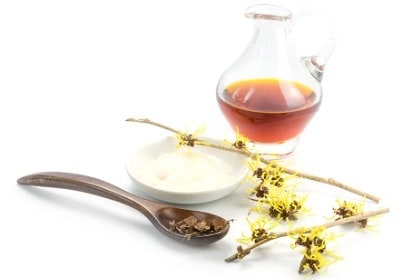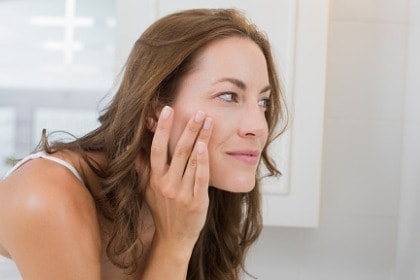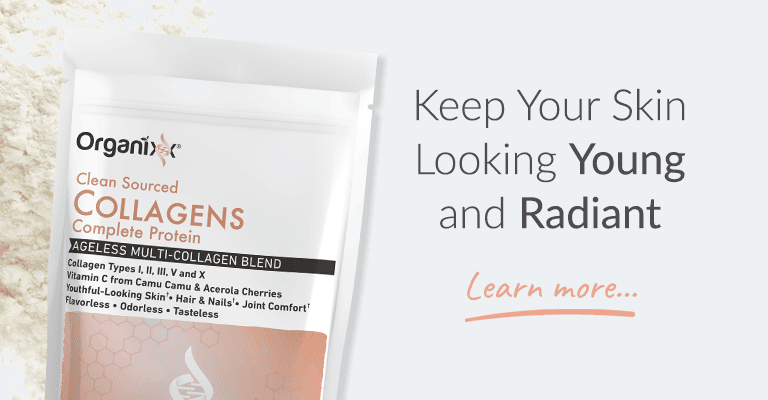Witch Hazel for Skin: A Lowly Shrub With “Magical” Qualities?
In a hurry? Click here to read the Article Summary...
Witch hazel has long been used as a tonic for the skin. You may even remember your mom or grandma rubbing it on with a cotton ball at night (that “rainstorm” kind of scent that emanated from the bottle is memorable). But have you ever wondered just what makes witch hazel for skin so beneficial and why extracts from the leaves, twigs, and bark of this humble shrub are a favorite in many quality skin toners and tighteners? Read on to discover more about witch hazel skin benefits!
What Does Witch Hazel Do?
Many of the myriad health benefits of American witch hazel (Hamamelis virginiana) have been known for centuries. Native American cultures in the Eastern U.S., such as the Osage, used the roots and leaves to treat sores and ulcers. The Potawatomi used it in steam baths (also called sweat lodges) for sore muscles.
Witch hazel has also been used traditionally to:
- treat colds and coughs
- help stop bleeding
- ease hemorrhoids
- and even help stop serious diseases like dysentery [1]
But what’s with that name, anyway? Hamamelis virginiana’s common name, witch hazel, alludes to some of its more mysterious (i.e., mystical or magical) qualities.
The Witch Hazel Tree

Hamamelis virginiana is a deciduous shrub or small tree that grows primarily in the Northeastern U.S., anywhere between Canada and Georgia.
One of its unusual qualities is that its “Y” shaped branches are some of the only you will find still sporting intensely-fragrant bright yellow-orange flowers deep into the winter [2].
Witch Hazel Branches Used for Dousing
Some also claim that witch hazel branches will bend when water is nearby, making them great tools to use for the art of “dowsing.” Although the more scientific-minded may brush this off as nonsense, others swear it is absolutely true.
“An Old Timer showed me how it works, and I have used it to find water, 20 to 30 wells, and every one of them had water right where I told them it was going to be,” claimed 72-year-old Curtis Strong of Hampton, Connecticut, in an interview on the subject for The Atlantic.
Strong’s family harvests witch hazel on their land for one of the only distilling companies in the United States to focus almost exclusively on products derived from the plant [3].
Also in support of the dousing claim is the fact that “wych” is a Middle English term for the word “bend.”
Other Interesting Witch Hazel Uses & Facts
Whatever its benefits in the more mysterious realms, it’s important to note that witch hazel has a solid and strong body of evidence-based scientific knowledge behind it as a medicinal plant.

In fact, witch hazel was one of the first plants to appear on the “mass market” in the United States and is one of the only herbs to be approved by the U.S. Food and Drug Administration as a non-prescription drug ingredient.
In addition, many studies point to its anti-inflammatory characteristics, and some research has also discovered substances within it that may be cancer-protective [4].
The secret to witch hazel’s success as a beneficial human health aid has to do with numerous kinds of tannins, esters, and other phytonutrients that are extremely balancing and protective for the body. These phytonutrients also help to reduce inflammation, a major factor in almost all chronic diseases.
Tannins, for example, are one unique example of the powerful antioxidant, age-defying, and anti-inflammatory properties found in witch hazel.
The term “tannins” may be best known by wine enthusiasts, but it turns out that many of the tannins in witch hazel (e.g., hamamelitannin and pentagalloylglucose) have cytotoxic effects on cancer cells [5].
Witch Hazel Skin Benefits
For most people, the phytonutrients found in witch hazel are best known for what they can do for the skin.
A side note here that witch hazel solutions from previous generations were often said to be drying to the skin. This is because these earlier formulations contained large amounts of ethanol alcohol, which is itself drying. Today, alcohol-free formulations are available that are much gentler on sensitive skin.

If you aren’t already a fan of witch hazel for skin, here are four ways witch hazel’s gentle cleansing, antioxidant, and antibacterial properties can help keep your face looking younger, softer, and smoother.
1. Witch Hazel Helps Fight Wrinkles
Witch hazel contains substances that directly promote the production of collagen and also help to keep it intact and strong.
A 2009 study conducted at Kingston University in London found that levels of a particular type of polyphenol called phenolic acid were high enough in witch hazel to inhibit the production of collagenase and elastase. These enzymes are responsible for the breakdown of peptide bonds in collagen and proteins in elastin.
Stopping this breakdown is important as the steady production of both collagen and elastin is needed to keep skin supple and wrinkles at bay [6].
2. Witch Hazel is an Astringent that Promotes Skin Tightening
Witch hazel is also an astringent. This means that besides having antioxidant and antibacterial properties, it also helps to tighten the skin naturally. This is mostly because of its anti-inflammatory and antioxidant properties.
Witch hazel’s skin-tightening effect helps pores seem smaller, which has the happy outcome of making your skin appear smoother with puffiness and discoloration less noticeable. This is why witch hazel can be especially beneficial for wrinkle spots near the eyes.
3. Witch Hazel Protects Against the Sun

The many kinds of tannins found in witch hazel provide the most influential antioxidant protection against the harmful UV rays of the sun. In fact, besides its antibacterial effects (which we will discuss in the next point), it is the antioxidant tannins within witch hazel that are the main reasons why many of the top quality face and eye creams and cleansers include this herb in their organic formulas.
A 2008 study conducted by researchers at the Institute for Chemical and Environmental Research in Barcelona, Spain, found that “(w)itch hazel phenolics protected red blood cells from free radical-induced hemolysis and were mildly cytotoxic to 3T3 fibroblasts and HaCat keratinocytes.”
In other words, the antioxidant load in witch hazel’s tannins and other phytonutrients is high enough that it may help to protect against melanoma in some cases [7].
4. Witch Hazel Helps Fight Acne
Witch hazel is also a known antibacterial. This means that blemishes, scarring, and other conditions related to bacterial overgrowth – including acne – can often be helped greatly by witch hazel.
A 2014 study published in the Journal of Clinical and Aesthetic Dermatology explains how chronic acne is actually an inflammatory disease that can be remedied with the help of powerful yet gentle-to-the-skin plants.
Researchers found that moisturizers containing “botanical anti-inflammatories” such as Aloe and witch hazel had the most positive effect on the signs and symptoms of chronic acne sufferers.
On the other hand, said the study authors, many common conventional treatments, such as antibiotics and synthetic creams, actually caused skin irritation [8].
Witch Hazel Has a Proven Track Record
As impressive as they are, the above four witch hazel skin benefits represent just the tip of the iceberg when it comes to all the conditions that witch hazel can be used for. Some other skin-related challenges that witch hazel may help include:
- bruises
- sores
- burns
- insect bites
- plant poisons (like poison oak or ivy)
- oily skin
- scalp issues
- allergic reactions
Organixx Clean Sourced Collagens blend contains five types of collagen from four sources. What’s more, it’s combined with targeted nutrients such as zinc, vitamin C, and vitamin B6 which specifically enhance the bioavailability and potency of collagen. Clean Sourced Collagens is formulated from the ground up to enhance and support your body’s natural ability to heal and rebuild itself from the INSIDE out.

 Sources:
Sources:
Article Summary
Many of the health benefits of American witch hazel (Hamamelis virginiana) have been known for centuries. In addition to skin benefits, witch hazel has been used traditionally to:
- treat colds and coughs
- help stop bleeding
- ease hemorrhoids
- help stop serious diseases like dysentery
Witch hazel was one of the first plants to appear on the “mass market” in the U.S. and is one of the only herbs to be approved by the U.S. Food and Drug Administration as a non-prescription drug ingredient.
For most people, the phytonutrients found in witch hazel are best known for what they can do for the skin.
Witch hazel’s gentle cleansing, antioxidant, and antibacterial properties can help keep your face looking younger, softer, and smoother.
4 ways witch hazel improves skin:
- Helps fight wrinkles
- Promotes skin tightening
- Protects against the sun
- Helps fight acne
Organically sourced witch hazel is an ingredient in both Organixx Restore Vitamin C Serum and our Renew Eye Cream.





Does witch hazel have any effect on skin disorders which are auto immune ?
Hi Madeleine!
Witch hazel does have anti inflammatory as well as anti viral properties. In which case it may be helpful for certain skin conditions. You may want to do a patch test and we recommend speaking with your doctor to see if it would be right for your specific skin needs.
Have a happy and healthy day! :)
Thank you for such an informative article. I would like to purchase some plants and I
live in zone 7 TN and think it would grow well here. Any idea where to purchase plants?
I love witch hazel to calm my Dry Eye Syndrome and as a cleanser twice a week.
Hi Judith, Thank you for sharing the ways you use this plant substance. I love it as well. I apply it to my face as part of my daily routine. May I ask how you are using it for dry eye syndrome? Looking forward to your reply. Enjoy your afternoon!
It was a good article. Did not know it was good for the items listed. What I’d like to know is how do you use it for cough and cold? for dysentery ? Can it be applied to skin undiluted?
Hi Mike, that is a great question. Yes, in most cases it can be applied to the skin undiluted. However, always do a patch test and check with your doctor on what is best for you. Here is an article from WEB MD regarding its usage. I have read where some people use the leaves of the plant as a tea for cough, cold and sore throat. However, I am unsure of the strength of the tea. https://www.webmd.com/vitamins-and-supplements/witch-hazel-uses-and-risks I hope you find this information helpful. Have a great day!
The link you directed the reader to article says nothing about using witch hazel for coughs or colds. Would be nice to actually find info on HOW to use it for coughs & colds.
Hi Carol! Thank you for your inquiry. The article briefly mentioned that it was brewed as tea to treat dysentery, colds, and coughs. Here is an article from WEB MD that talks more about it: https://www.webmd.com/vitamins-and-supplements/witch-hazel-uses-and-risks Also, here is another article located on the web that may help you get started with your research. https://chestnutherbs.com/witch-hazel-bloomoogling-unusual-male-parts-explosive-seeds-and-medicinal-uses/ I hope you find some useful information. Have a blessed day!